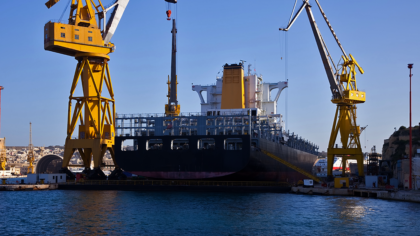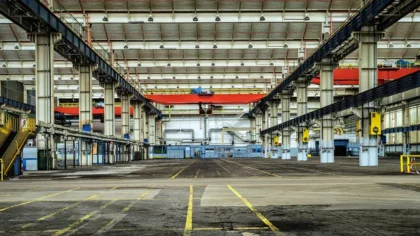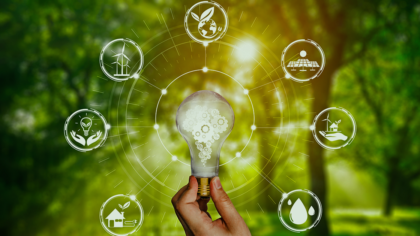The maritime industry leverages technologies to streamline operations and address challenges such as emissions reduction, fuel efficiency, and safety. For instance, AI-driven autonomous navigation systems optimize real-time route planning, reduce fuel consumption, and avoid collision risks by integrating data from radar, light detection and ranging (LIDAR) sensors and satellite positioning systems. In addition, IoT-based energy management platforms monitor engine parameters, fuel usage, and environmental conditions to enable predictive maintenance and minimize downtime. Simultaneously, blockchain solutions enhance supply chain transparency by securely tracking cargo from origin to destination, while big data analytics platforms process vast datasets to provide predictive insights into vessel performance and maintenance. Ultimately, each maritime technology enhances automation, sustainability, and operational resilience.
As these technologies further evolve, industry stakeholders must be proactive and integrate these solutions to ensure compliance and competitiveness on a global level. Delaying the adoption of these advancements risks operational inefficiencies, increased costs, and diminished market relevance.
Why should you read this report?
- Gain in-depth insights into the top 10 technologies impacting maritime companies
- Learn about three practical use cases for each technology
- Meet 10 innovative startups advancing these technologies

Key Takeaways
- Additive Manufacturing
- Use Cases:
- Rapid Prototyping
- On-Board Part Manufacturing
- Lightweight Component Fabrication
- Startup to Watch: PrisAM
- Use Cases:
- Artificial Intelligence (AI)
- Use Cases:
- Autonomous Navigation
- Cargo Optimization
- Safety Monitoring
- Startup to Watch: Soshianest
- Use Cases:
- Augmented Reality (AR) & Virtual Reality (VR)
- Use Cases:
- Design Visualization
- Remote Inspections
- Training Simulations
- Startup to Watch: VARCUS Solutions
- Use Cases:
- Big Data & Analytics
- Use Cases:
- Fuel Consumption Analysis
- Optimal Route Planning
- Safety & Risk Analysis
- Startup to Watch: TechBinder
- Use Cases:
- Blockchain
- Use Cases:
- Supply Chain Transparency
- Certification & Compliance Tracking
- Secure Payment Systems
- Startup to Watch: BunkerTrace
- Use Cases:
- CleanTech
- Use Cases:
- Alternative Fuel Systems
- Energy Efficient Design
- Green Ship Recycling
- Startup to Watch: Gelectric
- Use Cases:
- Cloud Computing
- Use Cases:
- Centralized Data Management
- Collaborative Ship Design
- Fleet Management
- Startup to Watch: omoqo
- Use Cases:
- Connectivity Technologies
- Use Cases:
- Enhanced Navigation Systems
- Remote Diagnostics & Support
- Real-Time Cargo Tracking
- Startup to Watch: CSignum
- Use Cases:
- Internet of Things (IoT)
- Use Cases:
- Energy Management
- Safety & Security Systems
- Crew Health Monitoring
- Startup to Watch: INILAB
- Use Cases:
- Advanced Robotics
- Use Cases:
- Automated Welding
- Underwater Inspections & Repairs
- Rescue & Emergency Response
- Startup to Watch: ZPARQ
- Use Cases:
Maritime Industry FAQs
What are the latest maritime technologies?
The latest maritime technologies focus on automation, sustainability, and advanced data integration to optimize shipping operations.
- Digital twins create real-time virtual replicas of vessels and systems to monitor performance and predict maintenance needs.
- Hybrid propulsion systems integrate both electric and traditional engines to reduce fuel consumption and emissions.
- Blockchain enhances supply chain transparency by securely tracking the movement of goods to prevent fraud and improve trust among global stakeholders.
- Advanced cybersecurity frameworks protect vessel networks and critical data from cyberattacks.
What are marine technology devices?
Marine technology devices improve navigation, monitoring, and maintenance of vessels.
- The dynamic positioning system uses sensors and a global positioning system (GPS) to automatically control a ship’s position and heading without manual intervention.
- Sonar systems in underwater mapping and navigation detect seabed structures and support safe passage in shallow or hazardous waters.
- Marine drones deployed for underwater inspections, environmental monitoring, and repair work allow for safer and more cost-efficient operations in difficult-to-reach environments.
- Smart buoys with sensors collect data on ocean conditions, aiding both environmental research and navigation safety.
Where is this Data from?
StartUs Insights provides data through its comprehensive Discovery Platform, which covers 4.7+ million startups, scaleups, and tech companies globally, as well as 20K+ emerging technology trends. The platform excels in startup and technology scouting, trend intelligence, and patent searches, offering a detailed view of the innovation landscape.
For this report, we analyzed technologies within specific industries using the trend intelligence feature. During this research, we identified patterns and trends, pinpointing relevant use cases and the startups developing solutions for each. More capabilities and details are available at StartUs Insights Discovery Platform.
10 Emerging Technologies Impacting Maritime Businesses [2025 & Beyond]
1. Additive Manufacturing

Additive manufacturing uses technologies such as 3D printing, laser sintering, and direct energy deposition to create customized components. This technology optimizes material usage and integrates generative design software as well as AI-driven algorithms to create lightweight yet durable parts that enhance vessel performance and reduce material waste. Further, high-performance alloys and composite materials, including metal-matrix composites and thermoplastics, extend the durability and thermal resistance of these components. During the printing process, real-time sensor data and AI-based monitoring systems ensure consistent quality control and fault detection, minimizing production errors. Thus additive manufacturing shortens production timelines, enhances flexibility in design iterations, and offers on-demand manufacturing capabilities.
3 Practical Use Cases of Additive Manufacturing in Maritime:
- Rapid Prototyping: Additive manufacturing creates detailed scale models and parts to reduce design cycle times. Because these models can be created quite fast and cheap, additive manufacturing allows to test and refine designs before full-scale production begins. This leads to faster development and deployment of new vessels or components.
- On-Board Part Manufacturing: The technology produces essential replacement parts directly on ships to eliminate reliance on external supply chains. This reduces downtime during voyages, optimizes operations, and resolves mechanical issues without waiting for land-based logistics.
- Lightweight Component Fabrication: Lightweight components are durable yet lighter parts, enhancing fuel efficiency. Deploying these components lowers fuel emissions, improves vessel performance, and reduces operational costs.
Startup to Watch: PrisAM
US-based startup PrisAM develops advanced, additively manufactured sandwich structures with lattice cores. Its proprietary Fused Filament Fabrication (FFF) hardware produces continuous trusses in non-planar geometries to enhance the strength-to-weight ratio of its panels. Further, the company reduces printing times and costs by optimizing material distribution and developing complex shapes. Its focus on predictive maintenance and sustainability through composite materials leads to stronger and lighter structures for naval vessels, unmanned aerial vehicles (UAVs), and radomes.
2. Artificial Intelligence

AI facilitates advanced data processing, real-time decision-making, and increased automation in the maritime sector. Using machine learning algorithms, predictive analytics, and neural networks, AI allows ships to process vast amounts of operational data for optimizing everything from navigation to maintenance. It assists in identifying inefficiencies, enhance safety measures, and streamline operations. Additionally, AI-driven platforms power smart ports, enabling better coordination of logistics, vessel traffic, and cargo handling, while also improving security and ensuring environmental compliance.
3 Practical Use Cases of Artificial Intelligence in Maritime:
- Autonomous Navigation: AI processes real-time data from sensors and cameras to guide vessels safely through complex routes and avoid obstacles. This technology minimizes human error, reduces large crew sizes, and lowers operational costs while enhancing operational safety and efficiency.
- Cargo Optimization: The technology analyzes data related to cargo weight, weather, and vessel stability to ensure precise load distribution. It maximizes space utilization and fuel efficiency to reduce overall shipping costs and enhance profitability for operators.
- Safety Monitoring: Advanced AI algorithms continuously monitor safety parameters on vessels to detect anomalies and potential hazards before they escalate into critical incidents. This approach prevents accidents, reduces maintenance and repair costs, and protects both assets and lives at sea.
Startup to Watch: Soshianest
3. Augmented Reality (AR) & Virtual Reality (VR)

AR integrates real-time data overlays onto physical environments to enhance situational awareness for ship crews and maintenance teams. In constrast, VR creates interactive simulations that allow operators to experience complex maritime scenarios in a controlled digital space. These technologies, combined with advanced sensors and data visualization platforms, enhance decision-making processes and improve collaboration between remote teams. The growing integration of AR and VR improves vessel design, crew training, and equipment management for more maritime operations.
3 Practical Use Cases of AR & VR in Maritime:
- Design Visualization: The technologies create immersive, 3D ship models that allow engineers to explore and modify designs before physical construction. This leads to more better designs, reduces costly revisions, and speeds up the decision-making process during the shipbuilding phase.
- Remote Inspections: For remote inspections, AR enables ship operators and inspectors to conduct detailed assessments of vessels without physical presence by using live video feeds and virtual overlays to identify issues. This lowers the travel and downtime costs, improves inspection accuracy, and enables quicker maintenance actions.
- Training Simulations: VR replicates real-life scenarios in a controlled, virtual environment to practice complex operations without risk. This improves safety, enhances skills, and reduces accidents while increasing the overall efficiency and safety of maritime operations.
Startup to Watch: VARCUS Solutions
Estonian startup VARCUS Solutions develops the ESBEN Augmented Navigation Bridge that enhances maritime navigation using AR and AI technologies. ESBEN integrates hardware to manage data from automatic identification systems (AIS) and automatic radar plotting aids (ARPA), while its software visualizes vessel courses, speeds, and surrounding ship information in real time. It operates without internet connectivity, utilizing a neural engine for high-accuracy calculations and blockchain for secure data sharing. With features like an advanced course predictor and real-time object marking, ESBEN allows operators to access navigation data via smartphones, tablets, or AR glasses, improving safety, situational awareness, and operational efficiency at sea.
4. Big Data & Analytics

Advanced analytics platforms process vast amounts of real-time data from ship sensors, weather systems, and supply chain networks to offer insights into vessel performance, fuel efficiency, and maintenance requirements. The integration of machine learning models and predictive analytics enhances forecasting capabilities to anticipate challenges and proactively optimize operations. The maritime industry leverages data lakes, cloud computing, and advanced visualization tools to convert traditional processes into highly efficient, digitally optimized systems that improve cost savings, safety, and environmental sustainability.
3 Practical Use Cases of Big Data & Analytics in Maritime:
- Fuel Consumption Analysis: Big data monitors real-time fuel usage patterns and adjusts engine performance based on environmental and operational factors. This reduces fuel costs and lowers emissions for the companies to align with sustainability goals while improving efficiency.
- Optimal Route Planning: Data analytics enhances optimal route planning by processing weather, traffic, and oceanographic data to identify the most efficient paths for vessels. It lowers operational costs, reduces fuel consumption, and improves punctuality in shipping schedules to reduce travel time and avoid hazards.
- Safety & Risk Analysis: Big data continuously gathers and evaluates data from multiple sources to detect potential hazards and patterns that indicate risks to vessels and crew. This monitoring prevents accidents, lowers maintenance costs, and enhances the overall safety standards in maritime operations.
Startup to Watch: TechBinder
Dutch startup TechBinder develops the Smart Vessel Optimizer (SVO), a solution that improves vessel performance using data already generated by maritime fleets. The technology benchmarks ship performance against operational metrics by identifying practices from top-performing vessels and applying these insights across the fleet to enhance efficiency. Its features include predictive analytics for asset availability, automated reporting to reduce administrative burdens, and an API that integrates with other business intelligence tools for data sharing. The solution enables vessel owners and operators to manage the total cost of ownership, improve operational consistency, optimize performance, and reduce costs.
5. Blockchain

Blockchain provides secure, decentralized platforms for managing complex transactions and data exchanges. Through distributed ledger systems, blockchain ensures that all parties involved in maritime operations have transparent, tamper-proof records of critical activities, from cargo documentation to financial settlements. Further, smart contracts automate contractual obligations and streamline processes between shipping companies, port authorities, and logistics providers. Overall, blockchain enhances data integrity and reduces intermediaries to increase operational efficiency, strengthen security protocols, and build trust across global maritime networks to secure shipping operations.
3 Practical Use Cases of Blockchain in Maritime:
- Supply Chain Transparency: Blockchain tracks goods through a transparent and immutable ledger to monitor each stage of the cargo movement in real time. This transparency level prevents discrepancies, ensures the authenticity of shipping documents, and optimizes global supply chain operations by improving the accuracy of logistics data and reducing the risk of lost or misdirected shipments.
- Certification & Compliance Tracking: The technology enhances certification and compliance management by securely storing and verifying digital certificates and regulatory documents throughout a vessel’s lifecycle. The tamper-proof nature of the blockchain ensures that these records remain accessible and unaltered to streamline audit processes, reduce manual interventions, and ensure continuous compliance with international maritime regulations.
- Secure Payment Systems: Blockchain-based payment systems secure transactions between shipping stakeholders to provide instant settlements without third-party intermediaries. This reduces transaction fees, increases the speed of cross-border payments, and enhances financial security for building trust and financial exchanges in international maritime trade.
Startup to Watch: BunkerTrace
UK-based startup BunkerTrace uses synthetic deoxyribonucleic acid (DNA) and blockchain to physically tag and digitally trace marine fuels throughout their lifecycle. Its technology embeds non-invasive molecular tracers into fuels and lubricants to create a tamper-evident seal that authenticates the integrity of bunker samples. On the blockchain, each tagged sample links to a secure digital record for real-time tracking and verification through a mobile app. In addition, features include rapid detection and authentication, smart data collection for an immutable audit trail, and chain of custody reporting for operational transparency. Thus, BunkerTrace’s technology prevents fuel tampering, verifies quality, and supports compliance with regulatory standards. It offers maritime operators trusted evidence for insurance claims, disputes, and carbon credit incentives.
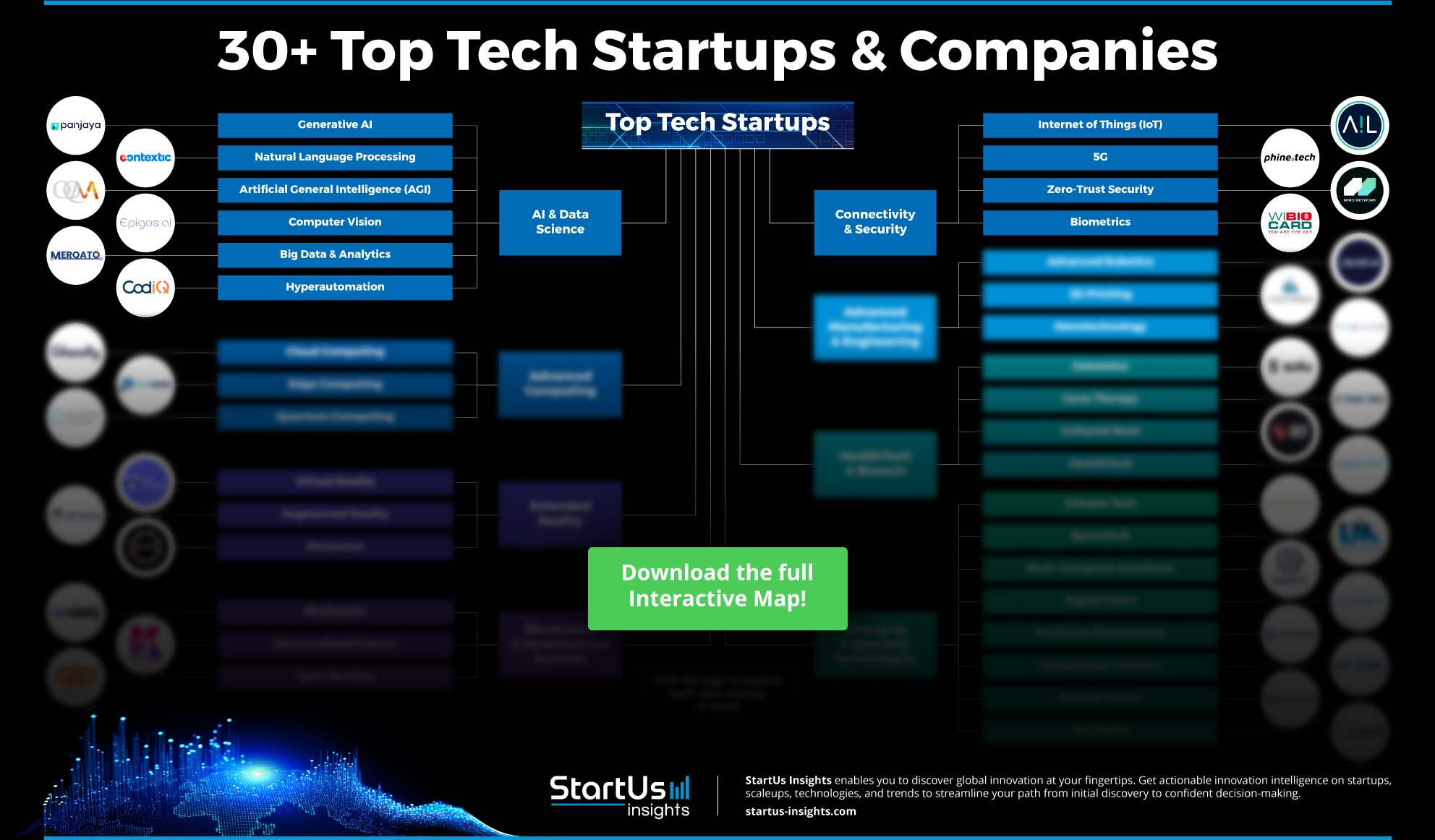
6. CleanTech

CleanTech focuses on emissions reduction, energy efficiency, and eco-friendly vessel designs. Innovations such as hydrogen fuel cells, wind-assisted propulsion systems, and next-generation batteries minimize their environmental impact while maintaining operational efficiency. Additionally, integrated energy management systems monitor and optimize power consumption on board to provide low-carbon and renewable energy solutions.
3 Practical Use Cases of CleanTech in Maritime:
- Alternative Fuel Systems: CleanTech introduces alternative fuel systems by using biofuels, hydrogen, and liquefied natural gas (LNG) as sustainable energy sources for ships, reducing dependency on fossil fuels. This lowers greenhouse gas emissions, meeting environmental regulations and promoting long-term sustainability.
- Energy Efficient Design: Design innovations optimize ship structures and propulsion systems to reduce energy consumption during voyages. These innovations save costs in fuel consumption, enhance operational efficiency, and reduce the industry’s carbon footprint.
- Green Ship Recycling: Green recycling incorporates environmentally responsible processes for dismantling vessels to repurpose materials while minimizing hazardous waste. This reduces environmental damage, conserves resources, and supports compliance with international recycling standards.
Startup to Watch: Gelectric
Dutch startup Gelectric provides an advanced cold ironing (or shore power) solution, enabling vessels to switch from diesel engines to shore-based electrical power while docking, reducing noise and emissions pollution in port areas. The technology integrates with existing vessel infrastructure to optimize energy management through precise revolutions per minute (RPM) control of shaft alternators, ensuring efficient electricity generation. By reducing fuel consumption and operating at optimal RPMs, Gelectric’s solution mimizes wear and tear and reduces maintenance costs. Moreover, it enhances energy efficiency, reduces operational expenses, and contributes to a greener maritime sector.
7. Cloud Computing

Cloud-based platforms leverage real-time data processing to manage vessel performance, optimize predictive maintenance, and enhance seamless communication between onshore control centers and offshore vessels. These platforms integrate IoT sensors to continuously monitor parameters, feeding vasts amount of data into AI-driven analytics engines that provide predictive insights on equipment health, fuel efficiency, and route optimization. By automating data collection and utilizing machine learning algorithms, cloud platforms detect anomalies and forecast maintenance needs before failures occur. Moreover, advanced analytics enable data-driven decisions, streamline fleet management, and enhance operational efficiency.
3 Practical Use Cases of Cloud Computing in Maritime:
- Centralized Data Management: Cloud computing allows real-time access to operational data across multiple vessels and ports to ensure efficient decision-making and data synchronization. This reduces manual data handling, lowers the risk of errors, and enhances operational transparency to provide more effective fleet-wide operations.
- Collaborative Ship Design: Collaborative design enables designers, engineers, and stakeholders to work on the same digital models regardless of their location. This speeds up the design process, enhances innovation, and reduces the costs associated with miscommunication and delayed project timelines.
- Fleet Management: Cloud-based solutions provide ship operators with insights into vessel performance, maintenance schedules, and route optimization accessible from a single platform. This improves fleet efficiency, reduces operational costs, and supports timely decision-making to ensure optimal fleet utilization.
Startup to Watch: omoqo
German startup omoqo offers a terminal operating system (TOM), boosting simplicity and transparency. TOM operates through modular terminal operating modules that activate or deactivate features based on their operational needs to ensure that terminals only pay for what they use. The system provides real-time data on terminal operations to eliminate inefficiencies and reduce manual tasks. Further, TOM reduces IT infrastructure costs by operating in the cloud to achieve optimal performance with minimal complexity.
8. Connectivity Technologies

Connectivity technologies integrate communication systems to ensure constant data exchange between vessels, ports, and onshore teams. Satellite communication networks, 5G maritime solutions, and vessel-to-vessel communication platforms enhance connectivity across global fleets to enable real-time monitoring and coordination. These technologies enhance navigation precision, facilitate remote diagnostics, and improve overall operational efficiency. In addition, they maintain continuous, high-speed connections in even the most remote sea environments to manage fleets, optimize logistics, and respond to dynamic operational challenges.
3 Practical Use Cases of Connectivity Technologies in Maritime:
- Enhanced Navigation Systems: Connectivity technologies improve navigation systems by providing vessels with real-time access to satellite data and weather conditions for precise route adjustments and collision avoidance. This reduces delays, enhances safety, and optimizes fuel efficiency for cost-effective operations.
- Remote Diagnostics & Support: Ship systems are monitored from anywhere in the world to identify and resolve technical issues without requiring specialized personnel on-site. This minimizes downtime, reduces maintenance costs, and ensures uninterrupted operations, especially during long voyages.
- Real-Time Cargo Tracking: Connectivity solutions provide constant visibility into the location and condition of shipments for better coordination and timely deliveries. This enhances supply chain efficiency, reduces loss and damage risks, and improves customer satisfaction by providing reliable delivery information.
Startup to Watch: CSignum
Scottish startup CSignum develops EM-2, a wireless communication platform that uses electromagnetic field signaling (EMFS) to transmit data through water, ice, rock, and soil for underwater and underground data transfer. The EM-2 enables bidirectional data transmission between underwater sensors and topside devices mounted on shore, buoys, or structures like wind turbines. CSignum’s solution further overcomes common barriers such as biofouling, environmental noise, and water-air interface reflection with applications ranging from internet of underwater things (IoUT) for infrastructure monitoring and ship hull analysis.
9. Internet of Things

IoT connects a network of sensors and devices that collect and transmit real-time data across vessels and port infrastructure. Its technologies enable advanced monitoring of critical ship systems, including engine performance, fuel consumption, and environmental conditions, while also providing predictive maintenance and enhanced safety protocols. With the integration of edge computing and cloud-based analytics, IoT platforms provide operators with insights that optimize efficiency, reduce downtime, and improve compliance with regulations.
3 Practical Use Cases of IoT in Maritime:
- Energy Management: The integration of IoT sensors into ships offers real-time data on fuel consumption and engine performance to make optimization strategies. This reduces fuel use, lowers operational costs, and supports compliance with environmental regulations while enhancing overall sustainability.
- Safety & Security Systems: IoT-powered safety and security systems continuously monitor vessel conditions, detect potential hazards or breaches, and enable prompt intervention. This approach minimizes risks to both assets and crew, ensures safer maritime operations, and reduces costly accidents or security incidents.
- Crew Health Monitoring: IoT devices track vital signs and environmental conditions on board to alert operators of potential health risks and ensure timely medical support. It enhances crew well-being, reduces health-related incidents, and ensures compliance with occupational safety standards for improved crew performance and morale.
Startup to Watch: INILAB
Danish startup INILAB offers Sensing-as-a-Service solution with KitOS, an operating system that enables real-time data collection, transmission, and processing through wireless technologies like long-range wide area network (LoRaWAN), long-term evolution (LTE), and WiFi. Also, INILAB’s system integrates multiple sensors to provide insights by converting raw data into actionable intelligence for real-time data streaming and analysis. The company’s approach allows for rapid prototyping and customized solutions to offer data visualization, system integration, and reliable connectivity over long distances.
10. Advanced Robotics

Advanced robotics introduces high-precision systems that automate complex tasks above and below water. Technologies including autonomous underwater vehicles (AUVs), remotely operated vehicles (ROVs), and robotic arms perform functions such as hull cleaning, structural inspections, and cargo handling. These robotics systems integrate Machine Learning and AI to enhance decision-making and adapt to dynamic maritime environments. This reduces human intervention in hazardous conditions and increases operational efficiency, optimizing maritime operations and safety standards.
3 Practical Use Cases of Advanced Robotics in Maritime:
- Automated Welding: Robotics automate welding processes to provide precision and consistency while reducing labor costs and human error during the fabrication of vessel components. This enhances production efficiency, shortens construction timelines, and improves the quality of maritime structures.
- Underwater Inspections & Repairs: Remotely operated vehicles (ROVs) are designed to perform complex tasks at extreme depths, allowing vessels to be examined and maintained without divers. This lowers human and operational risks, reduces maintenance costs, and ensures timely detection of critical issues to improve ship safety and longevity.
- Rescue & Emergency Response: Robotic systems enable faster and safer recovery efforts by deploying autonomous or remotely controlled robots in dangerous or hard-to-reach areas. This increases response times, improves the safety of rescue teams, and enhances the effectiveness of maritime emergency management while saving lives and reducing damage.
Startup to Watch: ZPARQ
Swiss startup ZPARQ develops submersible high-power motors using its open-pod technology for the motor to operate fully immersed in water without encapsulation. Moreover, this design minimizes moving parts and maximizes power output while maintaining a compact and lightweight form. Its benefits include minimal maintenance and low noise and provides a longer range and lower drag compared to conventional propulsion systems.
For more actionable insights, download our free Maritime Innovation Report.
Outlook for the Maritime Industry
Patents, Grants & Investment Landscape
The speed of innovation is evident with more than 118 900 patents and 10600 grants supporting the sector. Investment-wise, the sector attracted more than 7700 investors who participated in over 17700 funding rounds, with an average investment value of USD 64 million per round.
The top five investors include Techstars, Le Village by CA, Accelerateur PME ETI Nouvelle Aquitaine, Maritime Blue Innovation Accelerator, and Prequel Ventures. Moreover, the top five funding types are SEED, Early Stage VC/ Series A, Pre Seed, Angel, and Debt Financing.
Global Footprint
Key maritime hubs include the USA, UK, India, Australia, and Canada. Leading cities include London, Singapore, New York City, Dubai, and Mumbai.
Leverage Emerging Maritime Technologies
Act now on the emerging technologies transforming the maritime industry. With StartUs Insights, you swiftly discover hidden gems among over 4.7 million startups, scaleups, and tech companies, supported by 20K+ emerging technologies and trends. Our AI-powered search and real-time database ensure exclusive access to innovative solutions, making the global innovation landscape easy to navigate.
Trusted by industry leaders like Samsung, Nestlé, and Magna, we provide unmatched data, a 360-degree industry view, and data-driven intelligence for confident strategic decisions.
Leverage our innovation services to optimize costs, streamline operations, and stay ahead of the curve. Get in touch today to explore how our comprehensive innovation intelligence can drive your success.
Discover All Maritime Technologies & Startups!
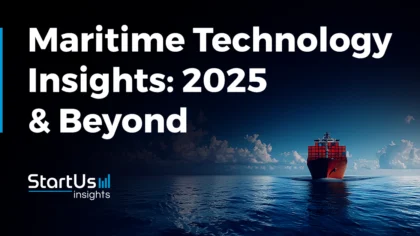
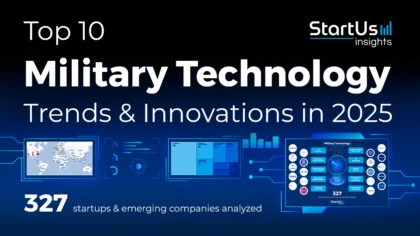
![15 Top Defense Companies and Startups to Watch in Europe [2025]](https://www.startus-insights.com/wp-content/uploads/2025/03/Defense-Companies-in-Europe-SharedImg-StartUs-Insights-noresize-420x236.webp)


